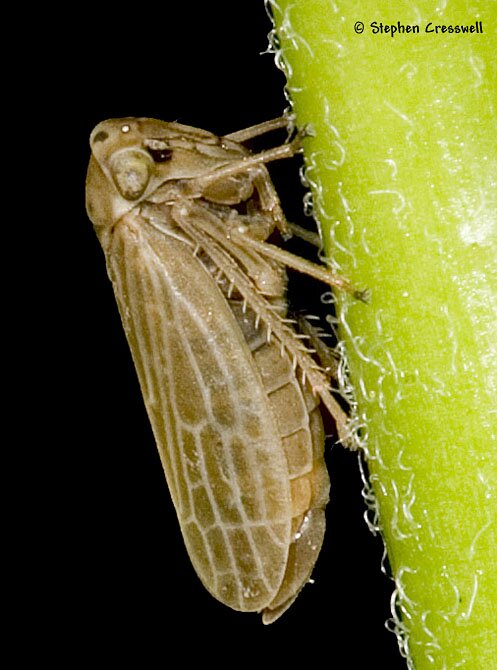
Family: Cicadellidae
Subfamily: Agalliinae
Length: typically 3.2-3.3 mm
Two common leafhoppers in West Virginia are Agalliota constricta and A. quadripunctata. For identification, if the leafhopper in question lacks spots on the pronotum, it would be wise to look first at A. constricta. If the pronotum has two spots and the head has two, then the leafhopper may be A. quadripunctata. Unfortunately for the cause of simple identifications, A. constricta sometimes has the pronotal spots, and in that case it is necessary to compare body shape. As its scientific name implies, A. constricta is more slender, while A. quadripunctata is more robust than its congener.
Shaw (1976) reported on the sounds produced by Agalliota constricta, and behaviors associated with sound production. Like Cicadas, leafhoppers produce sounds using tymbalsvibrating membranes located on the abdomen.
When Shaw placed a male and a female Agalliota constricta into an observation chamber, usually the male emitted some calls, which were sometimes answered by the female. If the female did answer, the two soon began to alternate the calls. The female participation in the alternation of the calls served to alert the male that a sexually receptive female was nearby, and mating behavior usually followed. The sound pattern of the calls is different for each species, and thus one function of the calling is to assure both the male and the female that the other calling individual is indeed of the same species.
Right: Agalliota quadripunctata on a plant stem, taking a break from feeding, its beak-like mouthparts tucked away under the head. Note the sharp carina or ridge along the top front edge of the head.
Researchers at the University of Mississippi reported that Agalliota constricta was one of the more common species feeding in Ole Miss's famed Marijuana garden (the crop is grown for research purposes and largely funded by the U.S. government). The researchers did not mention any erratic behavior on the part of the dining leafhoppers.

Left: The face of an Agalliota leafhopper. The genus name Agallia has also been applied to this group. Nomina Insecta Nearctica uses Agalliota, a name that separates the New World species from related Old World species.
A number of writers have noted that males of Agalliota quadripunctata are rare, and that the vast majority of collected specimens was female. Black and Oman (1947) verified in the laboratory that this species reproduces through parthenogenesis. They commented, "The presence of males in some populations of quadripunctata may indicate that at times the species does reproduce bisexually. On the other hand, such males may be nonfunctional."
This website also features the tiny nymph of Agalliota sp.



